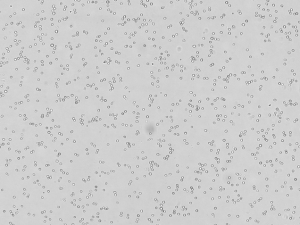Jurkat is an acute T cell leukemia cell line originally derived from the peripheral blood of a 14-year-old boy. The original Jurkat clone was designated JM*. The E6-1 clone, derived from JM, is now the Jurkat cell line used most frequently by researchers, but many other clones or derivatives are available. Jurkat cells are widely used for IL-2 production and in the study of acute T cell leukemia, T cell signaling, and the effectiveness of potential anti-cancer compounds. Jurkat cells were used to establish the Nexcelom Apoptosis (Annexin V-FITC / PI) and PI Cell Cycle protocols for the Vision CBA Analysis System.
Clone Evaluated: Jurkat, E6-1**
Adherent / Non-adherent: non-adherent
Cell Type: lymphoblast; T lymphocyte
Cell Source: acute T cell leukemia
Doubling Time: 48 hours
Protein Expression: cells can be induced to produce large amounts of Interleukin-2
Recommended Media: RPMI-1640 with 10% FBS
*Schneider, U. et al. (1977). Characterization of EBV-genome negative “null” and “T” cell lines derived from children with acute lymphoblastic leukemia and leukemic transformed non-Hodgkin lymphoma. Int. J. Cancer. 19: 621-626
**Weiss, A. et al. (1984). The Role of T3 Surface Molecules in the Activation of Human T Cells: a Two-Stimulus Requirement for IL-2 Production Reflects Events Occurring at a Pre-translational Level. J. Immunol. 133: 123-128.







Leave A Comment